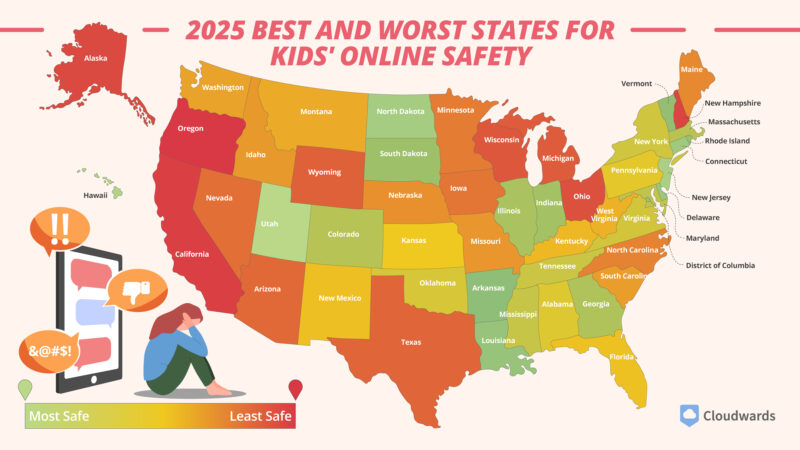The Best and Worst US States for Kids’ Online Safety in 2025
In this study on the best and worst U.S. states for kids' online safety, we explore how each state fares on issues like cyberbullying, online harassment, internet safety legislation and mental health support.
Though the internet can add extra dimensions to kids’ education and enrichment, the prevalence of cyberbullying and online predation is a major concern for parents and guardians. In the spirit of raising awareness about these issues and encouraging positive change, we compiled and analyzed data to reveal the worst and best states for kids’ online safety in the U.S.
We gathered data for each U.S. state in four categories and used this information to create our ranking:
- Online safety crimes and threats
- Cyberbullying prevalence
- Cyberbullying and online safety legislation
- Mental health support
In addition to this list, we share key findings from our data analysis and what they might suggest about child online safety across the U.S.
-
01/13/2025 Facts checked
Updated map to reflect the situation in 2025.
Map of the Best and Worst States for Kids’ Internet Safety

Key Takeaways: Child Online Safety in the US
After analyzing online safety data related to each U.S. state and conducting further research, we deduced the following key findings:
- Best States: Utah ranks at the top of the kids’ online safety ranking thanks to its comprehensive online safety legislation, strong mental health support and moderate levels of online safety crimes and threats. Hawaii narrowly missed the top spot; its mental health support score brought down its otherwise strong average.
- West Coast Region: West Coast states like California (50th) and Oregon (51st) are ranked among the worst states for kids’ online safety. Though renowned for its technology industry, California ranks number 50 for kids’ online safety, having performed particularly poorly in the “online safety crimes and threats” category.
- Midwest Region: The states of North Dakota, South Dakota, Indiana and Illinois stand out from other Midwestern states in terms of overall child online safety. Other Midwestern states are middle of the road or rank toward the bottom of the list.
- East Coast Region: Several East Coast states sit at the top of the ranking, including New Jersey (3rd), Connecticut (5th) and Delaware (6th).
- Southern Region: The middle portion of the ranking (from 19th to 30th place) is populated with several Southern states, including Mississippi, Tennessee, Virginia, Alabama, Kentucky and West Virginia. This indicates that even though the South isn’t the worst for kids’ online safety, there are still improvements to be made.
- Child Well-Being: There’s a correlation between our data on internet safety for kids and the results of a 2022 report on state trends in child well-being by The Annie E. Casey Foundation. The report named Utah, Vermont, New Jersey and Connecticut as being among the top states for overall child well-being.
Listing the Best & Worst States for Kids’ Online Safety
The table below ranks each state from 1 (best) to 51 (worst) in terms of child online safety based on scores in four categories. The District of Columbia is included in this list. We explain our methodology later on, and you can consult the table notes below for more information.
| Rank: | State | Total Score | Crimes & Threats | Cyberbullying | Cyberbullying & Safety Legislation | Mental Health Support |
|---|---|---|---|---|---|---|
| 1. | Utah | 85.32 | 21 | 29 | 1 | 7 |
| 2. | Hawaii | 85.05 | 5 | 5 | 9 | 25 |
| 3. | New Jersey | 84.01 | 34 | 22 | 1 | 10 |
| 4. | North Dakota | 83.50 | 4 | 11 | 9 | 32 |
| 5. | Connecticut | 82.99 | 19 | 14 | 9 | 9 |
| 6. | Delaware | 82.47 | 3 | 1 | 20 | 22 |
| 7. | Louisiana | 82.23 | 24 | 44 | 1 | 44 |
| 8. | District of Columbia | 81.95 | 22 | 2 | 20 | 1 |
| 9. | Arkansas | 81.84 | 16 | 48 | 1 | 40 |
| 10. | Vermont | 81.28 | 1 | 35 | 9 | 15 |
| 11. | Rhode Island | 81.18 | 10 | 3 | 20 | 3 |
| 12. | South Dakota | 80.17 | 9 | 37 | 9 | 41 |
| 13. | Indiana | 80.08 | 29 | 21 | 9 | 27 |
| 14. | Illinois | 79.94 | 47 | 40 | 1 | 5 |
| 15. | Georgia | 79.23 | 40 | 10 | 9 | 46 |
| 16. | Colorado | 77.91 | 37 | 32 | 9 | 11 |
| 17. | Massachusetts | 77.35 | 31 | 16 | 20 | 2 |
| 18. | Maryland | 77.25 | 32 | 12 | 20 | 4 |
| 19. | Mississippi | 76.97 | 20 | 18 | 20 | 51 |
| 20. | Tennessee | 76.94 | 35 | 38 | 9 | 48 |
| 21. | New York | 76.63 | 48 | 24 | 1 | 6 |
| 22. | Virginia | 75.95 | 43 | 6 | 20 | 17 |
| 23. | Oklahoma | 75.37 | 25 | 23 | 20 | 50 |
| 24. | Alabama | 75.24 | 36 | 13 | 20 | 49 |
| 25. | Pennsylvania | 75.22 | 46 | 39 | 9 | 19 |
| 26. | Kansas | 75.03 | 18 | 34 | 20 | 37 |
| 27. | Florida | 75.00 | 49 | 8 | 1 | 35 |
| 28. | New Mexico | 74.77 | 15 | 7 | 34 | 43 |
| 29. | Kentucky | 73.63 | 27 | 41 | 20 | 34 |
| 30. | West Virginia | 73.16 | 14 | 49 | 20 | 16 |
| 31. | Montana | 72.65 | 7 | 28 | 34 | 13 |
| 32. | Washington | 72.27 | 44 | 26 | 20 | 28 |
| 33. | South Carolina | 72.19 | 44 | 17 | 34 | 39 |
| 34. | Idaho | 72.06 | 13 | 31 | 34 | 14 |
| 35. | Missouri | 72.05 | 33 | 15 | 34 | 21 |
| 36. | Nebraska | 71.78 | 12 | 36 | 34 | 8 |
| 37. | Maine | 70.75 | 8 | 42 | 34 | 33 |
| 38. | North Carolina | 70.67 | 42 | 9 | 34 | 20 |
| 39. | Minnesota | 70.47 | 28 | 25 | 34 | 24 |
| 40. | Iowa | 69.97 | 11 | 45 | 34 | 29 |
| 41. | Nevada | 69.79 | 38 | 19 | 34 | 38 |
| 42. | Arizona | 68.46 | 45 | 47 | 20 | 47 |
| 43. | Texas | 68.26 | 50 | 4 | 1 | 36 |
| 44. | Wyoming | 67.81 | 2 | 30 | 48 | 42 |
| 45. | Michigan | 67.75 | 41 | 33 | 34 | 18 |
| 46. | Wisconsin | 66.54 | 23 | 27 | 48 | 26 |
| 47. | Ohio | 66.00 | 39 | 43 | 34 | 45 |
| 48. | Alaska | 64.51 | 17 | 46 | 48 | 31 |
| 49. | New Hampshire | 63.05 | 6 | 50 | 48 | 23 |
| 50. | California | 55.92 | 51 | 20 | 9 | 12 |
| 51. | Oregon | 50.44 | 30 | 51 | 34 | 30 |
Internet Safety for Kids in America: Understanding the Data
Let’s explore some of the key findings of our research in more detail and the factors that influence a state’s position in the ranking.
Top States for Kids’ Online Safety
The results show that no state has a perfect approach to issues regarding kids’ online safety. Performance differed — sometimes wildly — across different categories. However, Utah, Hawaii, New Jersey, North Dakota and Connecticut were the five best-performing states overall.
Utah and New Jersey received perfect scores for online safety legislation and respectable scores for mental health support, but the other top states had a lower prevalence of cyberbullying, online crimes and cyber threats. Hawaii, which was a close second to Utah, did well in every category except mental health, in which it received a score of 25.
Utah made history in 2023 by becoming the first state to pass a social media act ruling that age verification on social media become a requirement, in addition to the restriction of certain features like direct messaging. The state has since repealed and amended the original act in response to a constitutionality challenge by NetChoice.
Several East Coast states also made it into the top 15: New Jersey, Connecticut, Delaware, District of Columbia, Vermont, Rhode Island and Georgia. Notably, many of these states received high or at least respectable scores for mental health support, with the District of Columbia taking the lead in this category with a score of 1.
Furthermore, we noticed that several of the states named as the best for child well-being in a 2022 report by The Annie E. Casey Foundation, including Utah, Vermont, New Jersey, Connecticut and North Dakota, can also be found in our top 10.
States With the Highest Online Safety Risks for Kids
Several West Coast states — including California, Oregon and Alaska (which is sometimes referred to as a West Coast state for bureaucratic purposes) — ranked at the bottom. The states with the worst rankings overall are Ohio (47), Alaska (48), New Hampshire (49), California (50) and Oregon (51).
Oregon
Our research revealed that while Oregon ticks a lot of boxes when it comes to cyberbullying and online safety legislation, cyberbullying laws do not cover off-school campus incidents. The state also received a score of zero for sexting laws and has not implemented the 2023 Social Media & Children legislation.
Moreover, Oregon’s percentage in the “been cyberbullied” category is 65.2%, one of the highest in the whole ranking. This contributed to its terrible score in the cyberbullying prevalence category, but its scores were unimpressive across the board.
Tech States
Another observation that piqued our interest is that states containing some of the top tech cities in the U.S., like North Carolina (Raleigh), Texas (Plano, Austin and Frisco) and California (San Francisco), are among the riskiest areas for child online safety, according to our data.
The category that brought California down to 50th place is online safety threats, including rates of crimes against children, harassment and stalking, and threats of violence. In 2023, the FBI Internet Crime Report flagged tech hub California as the state with the most cybercrime complaints. Texas, which ranks 43 out of 51 on our list and is also known for its tech prowess, came in second in the FBI’s report after California.
That said, our data shows that California received decent mental health support and child online safety legislation scores, which saved it from coming in last on our list.
In addition, we noticed that some of the states the FBI listed as having the fewest cybercrime complaints in 2023 — including Vermont, North Dakota and Rhode Island — are near the top of our child online safety ranking.
5 Key Internet Safety Tips for Kids
The prevalence of internet crimes against children is incredibly worrying, but there are some steps you and your child can take to help reduce the risk and feel safer online. Here are some key internet tips for kids.
- Be careful about the information you share: Never post details like your address, school, phone number or date of birth anywhere online. The same goes for photos that may reveal details about you, like a photo of a certificate with your full name or your school’s name. Setting your social media profiles to “private” can help you stay safe.
- Never meet up with people you meet online. If someone asks you to meet them in real life, let a parent or guardian know right away.
- Don’t open links you receive via email or private messaging. These could be from people trying to get your personal information.
- Use strong passwords and never share them with anyone. Parents and guardians can increase security by making sure antivirus software, password managers and multi-factor authentication are up and running.
- If you’re a parent or guardian, regularly communicate with your child about the importance of online safety. Let your child know that they can always talk to you if they have any questions or feel uncomfortable about something online.
Methodology
To create our ranking, we collected data on each state in four categories split into various factors. The data was normalized in a range of 0 to 1, and each factor was assigned weight points based on its overall significance to create a total score for the respective category.
Each state’s performance as a whole across all categories determined its ranking on the list. We distributed weight points across all categories and factors as follows:
Sources:
We used the following sources to research the issue of kids’ online safety and collect data for the four categories mentioned above:
- Internet Crime Complaint Center (IC3)
- Cyberbullying Research Center
- cdc.gov
- National Conference of State Legislatures
- U.S. Bureau of Labor Statistics
- Psychology Today
Final Thoughts: Children Online in America
It’s clear that some states are ahead of the pack when it comes to online child protection, but it’s important to bear in mind that these scores are simply averages. Most states on this list have a combination of strengths and weaknesses. Though some performed excellently in some areas, their scores in other areas were poor enough to knock them out of the running for a top spot.
To summarize, every state still has work to do on the matter of internet safety for kids. What do you think of our ranking? Were you surprised by any of the states’ positions? Let us know in the comments, and thanks for reading.
FAQ: Protect Kids Online
Internet safety for kids is all about knowing how to surf the net and use social media responsibly to reduce the risk of being targeted by cybercriminals.
According to our data, Utah is the safest state for kids online. Its excellent online safety legislation score and strong mental health support score helped push it into the top spot.
Based on our study, Oregon is the most unsafe state for kids online due to its below-average to poor scores across the board and particularly high levels of cyberbullying prevalence.
Setting boundaries and communicating calmly and openly about the potential risks are two of the most important aspects of teaching online safety to kids. Child-friendly books and media about online safety may also be useful.


